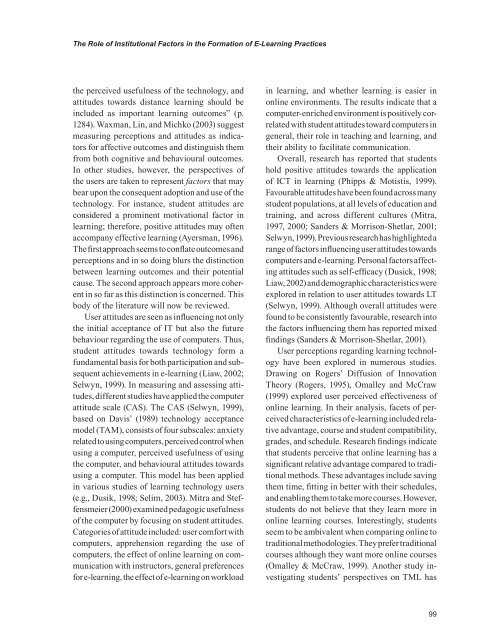Advances in E-learning-Experiences and Methodologies
Create successful ePaper yourself
Turn your PDF publications into a flip-book with our unique Google optimized e-Paper software.
The Role of Institutional Factors <strong>in</strong> the Formation of E-Learn<strong>in</strong>g Practices<br />
the perceived usefulness of the technology, <strong>and</strong><br />
attitudes towards distance learn<strong>in</strong>g should be<br />
<strong>in</strong>cluded as important learn<strong>in</strong>g outcomes” (p.<br />
1284). Waxman, L<strong>in</strong>, <strong>and</strong> Michko (2003) suggest<br />
measur<strong>in</strong>g perceptions <strong>and</strong> attitudes as <strong>in</strong>dicators<br />
for affective outcomes <strong>and</strong> dist<strong>in</strong>guish them<br />
from both cognitive <strong>and</strong> behavioural outcomes.<br />
In other studies, however, the perspectives of<br />
the users are taken to represent factors that may<br />
bear upon the consequent adoption <strong>and</strong> use of the<br />
technology. For <strong>in</strong>stance, student attitudes are<br />
considered a prom<strong>in</strong>ent motivational factor <strong>in</strong><br />
learn<strong>in</strong>g; therefore, positive attitudes may often<br />
accompany effective learn<strong>in</strong>g (Ayersman, 1996).<br />
The first approach seems to conflate outcomes <strong>and</strong><br />
perceptions <strong>and</strong> <strong>in</strong> so do<strong>in</strong>g blurs the dist<strong>in</strong>ction<br />
between learn<strong>in</strong>g outcomes <strong>and</strong> their potential<br />
cause. The second approach appears more coherent<br />
<strong>in</strong> so far as this dist<strong>in</strong>ction is concerned. This<br />
body of the literature will now be reviewed.<br />
User attitudes are seen as <strong>in</strong>fluenc<strong>in</strong>g not only<br />
the <strong>in</strong>itial acceptance of IT but also the future<br />
behaviour regard<strong>in</strong>g the use of computers. Thus,<br />
student attitudes towards technology form a<br />
fundamental basis for both participation <strong>and</strong> subsequent<br />
achievements <strong>in</strong> e-learn<strong>in</strong>g (Liaw, 2002;<br />
Selwyn, 1999). In measur<strong>in</strong>g <strong>and</strong> assess<strong>in</strong>g attitudes,<br />
different studies have applied the computer<br />
attitude scale (CAS). The CAS (Selwyn, 1999),<br />
based on Davis’ (1989) technology acceptance<br />
model (TAM), consists of four subscales: anxiety<br />
related to us<strong>in</strong>g computers, perceived control when<br />
us<strong>in</strong>g a computer, perceived usefulness of us<strong>in</strong>g<br />
the computer, <strong>and</strong> behavioural attitudes towards<br />
us<strong>in</strong>g a computer. This model has been applied<br />
<strong>in</strong> various studies of learn<strong>in</strong>g technology users<br />
(e.g., Dusik, 1998; Selim, 2003). Mitra <strong>and</strong> Steffensmeier<br />
(2000) exam<strong>in</strong>ed pedagogic usefulness<br />
of the computer by focus<strong>in</strong>g on student attitudes.<br />
Categories of attitude <strong>in</strong>cluded: user comfort with<br />
computers, apprehension regard<strong>in</strong>g the use of<br />
computers, the effect of onl<strong>in</strong>e learn<strong>in</strong>g on communication<br />
with <strong>in</strong>structors, general preferences<br />
for e-learn<strong>in</strong>g, the effect of e-learn<strong>in</strong>g on workload<br />
<strong>in</strong> learn<strong>in</strong>g, <strong>and</strong> whether learn<strong>in</strong>g is easier <strong>in</strong><br />
onl<strong>in</strong>e environments. The results <strong>in</strong>dicate that a<br />
computer-enriched environment is positively correlated<br />
with student attitudes toward computers <strong>in</strong><br />
general, their role <strong>in</strong> teach<strong>in</strong>g <strong>and</strong> learn<strong>in</strong>g, <strong>and</strong><br />
their ability to facilitate communication.<br />
Overall, research has reported that students<br />
hold positive attitudes towards the application<br />
of ICT <strong>in</strong> learn<strong>in</strong>g (Phipps & Motistis, 1999).<br />
Favourable attitudes have been found across many<br />
student populations, at all levels of education <strong>and</strong><br />
tra<strong>in</strong><strong>in</strong>g, <strong>and</strong> across different cultures (Mitra,<br />
1997, 2000; S<strong>and</strong>ers & Morrison-Shetlar, 2001;<br />
Selwyn, 1999). Previous research has highlighted a<br />
range of factors <strong>in</strong>fluenc<strong>in</strong>g user attitudes towards<br />
computers <strong>and</strong> e-learn<strong>in</strong>g. Personal factors affect<strong>in</strong>g<br />
attitudes such as self-efficacy (Dusick, 1998;<br />
Liaw, 2002) <strong>and</strong> demographic characteristics were<br />
explored <strong>in</strong> relation to user attitudes towards LT<br />
(Selwyn, 1999). Although overall attitudes were<br />
found to be consistently favourable, research <strong>in</strong>to<br />
the factors <strong>in</strong>fluenc<strong>in</strong>g them has reported mixed<br />
f<strong>in</strong>d<strong>in</strong>gs (S<strong>and</strong>ers & Morrison-Shetlar, 2001).<br />
User perceptions regard<strong>in</strong>g learn<strong>in</strong>g technology<br />
have been explored <strong>in</strong> numerous studies.<br />
Draw<strong>in</strong>g on Rogers’ Diffusion of Innovation<br />
Theory (Rogers, 1995), Omalley <strong>and</strong> McCraw<br />
(1999) explored user perceived effectiveness of<br />
onl<strong>in</strong>e learn<strong>in</strong>g. In their analysis, facets of perceived<br />
characteristics of e-learn<strong>in</strong>g <strong>in</strong>cluded relative<br />
advantage, course <strong>and</strong> student compatibility,<br />
grades, <strong>and</strong> schedule. Research f<strong>in</strong>d<strong>in</strong>gs <strong>in</strong>dicate<br />
that students perceive that onl<strong>in</strong>e learn<strong>in</strong>g has a<br />
significant relative advantage compared to traditional<br />
methods. These advantages <strong>in</strong>clude sav<strong>in</strong>g<br />
them time, fitt<strong>in</strong>g <strong>in</strong> better with their schedules,<br />
<strong>and</strong> enabl<strong>in</strong>g them to take more courses. However,<br />
students do not believe that they learn more <strong>in</strong><br />
onl<strong>in</strong>e learn<strong>in</strong>g courses. Interest<strong>in</strong>gly, students<br />
seem to be ambivalent when compar<strong>in</strong>g onl<strong>in</strong>e to<br />
traditional methodologies. They prefer traditional<br />
courses although they want more onl<strong>in</strong>e courses<br />
(Omalley & McCraw, 1999). Another study <strong>in</strong>vestigat<strong>in</strong>g<br />
students’ perspectives on TML has


